Definition
Hip abduction refers to the movement of the hip joint as the leg is moved away from the midline of the body. As the hip is composed of a ball and socket joint, a degree of rotation is also present during this motion. A group of muscles contribute to hip abduction; the most important of these is the gluteus medius.
What is Hip Abduction?
Acetabulofemoral joint abduction is tested in clinical settings by having the individual lie on one side and lifting one leg vertically away from the floor. Side splits are an example of excessive bilateral hip abduction.
To see how the hip joint moves during this action we first need to look at how the two bones interact.
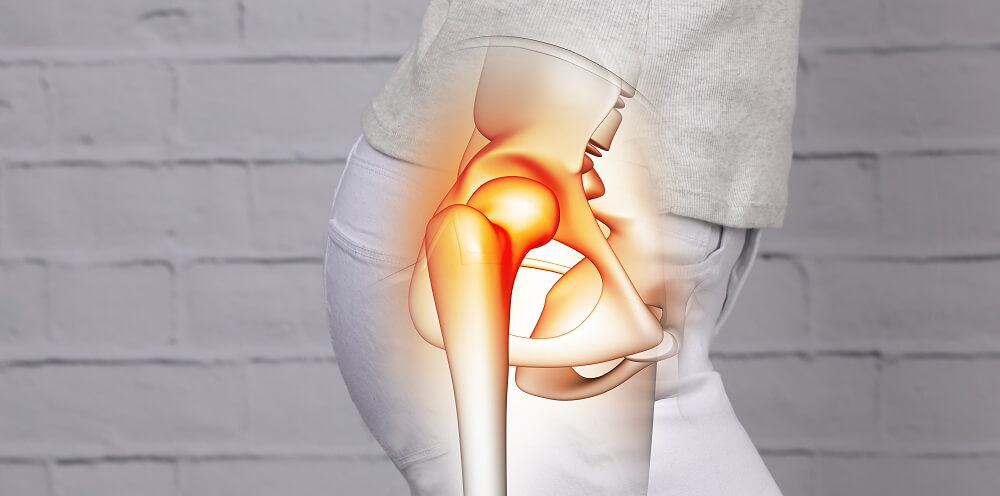
Abetabulofemoral Joint
The hip joint is a paired ball and socket joint that connects the pelvis to the legs. It is the meeting point of two bones – the pelvis and the head of the femur. As a multiaxial joint, the acetabulofemoral joint has a broad range of motion; abduction is just one of these. From the hip we can carry out the following types of movement:
- Flexion: bringing the leg forward, such as when walking and climbing stairs.
- Extension: bringing the leg back, as when walking (the trailing leg).
- Abduction: bringing the leg out to the side, such as when doing the splits.
- Adduction: bringing the leg back to the midline from an abducted position.
- External rotation: rotating the leg outward, such as when sitting on a horse.
- Internal rotation: rotating the leg inward, as with knock-knees.
- Circumduction: swinging one leg in a circular motion
All of these movements are possible thanks to the ball and socket structure of the hip joint and a large number of contributing muscles. These muscles not only allow movement but stabilize the hip. As the hips support the weight of the upper body and bear shocks that run upward from the lower body, this is an extremely stable joint.
Where the rounded head of the femur fits into the pelvis is called the acetabulum. This is a concave dent in the pelvis constructed from the ischium, ilium, and pubis bones. The acetabulum is surrounded by a ridge that stops the ball of the femur head from slipping out of place.

The top of the femur has three important structures. To the outside of the hip is the greater trochanter that you can feel through the skin to the side of the thigh. The greater trochanter is an attachment point for various hip muscles. The femur neck exits the inner surface of the greater trochanter and supports the rounded femur head. This neck is the weakest part of the femur bone and is the most common area of damage.

The acetabulofemoral joint is protected by a layer of smooth articular cartilage. This covers the head of the femur and the lunate surface of the acetabulum. The lunate surface refers to a crescent moon-shaped indentation. The entire joint is supported by strong ligaments that help to keep the hip joint stable during movement.
Abduction Muscles
Without muscles, there is no control of hip motion. Hip abduction muscles both contract and relax to allow for this movement; these are agonist and antagonist muscles respectively. An agonist usually contracts while the opposing antagonist relaxes.
The most important agonist of hip abduction is the gluteus medius muscle pictured below. This muscle lies partially under the larger gluteus maximus of the buttock. When the leg is lifted away from the midline the gluteus medius fibers contract. Other muscles help this motion as synergists. They increase the level of force but also work to stabilize the joint during hip abduction. Synergists are the psoas, piriformis, tensor fascia latae (TFL), quadratus lumborum, and rectus femoris muscles.
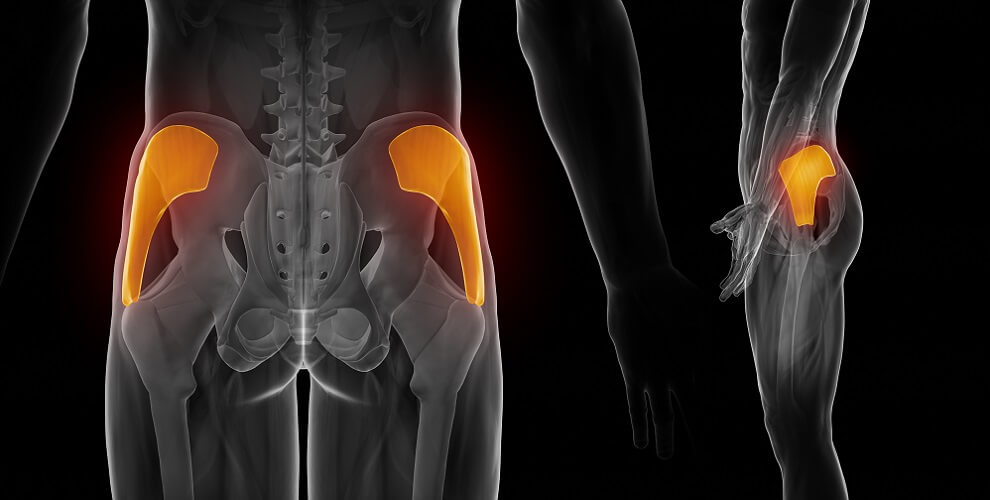 As the above-mentioned muscles contract, hip abduction antagonists relax. These are the hip adductor muscles. There are five hip adductors:
As the above-mentioned muscles contract, hip abduction antagonists relax. These are the hip adductor muscles. There are five hip adductors:
- Adductor magnus
- Adductor brevis
- Adductor longus
- Pectineus
- Gracilis
This shows us that the hip abduction range of motion requires contributions from eleven hip muscles.
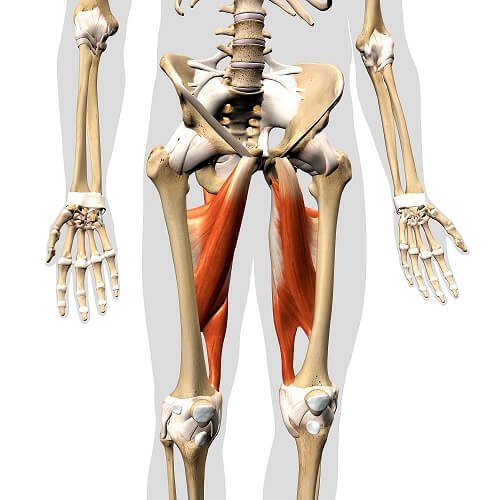
Hip Abduction Range of Motion
Normal hip abduction ROM – specifically side-lying hip abduction– is between thirty to fifty degrees. This range of motion (ROM) is measured using a goniometer.

Abduction of the hip can also be measured with the person in a supine position – that is, lying on the back – with similar normal ROM results. The non-measured leg (the ipsilateral hip) remains extended on the floor. When measuring hip abduction range of motion in a side-lying position a digital inclinometer can be placed on the thigh.
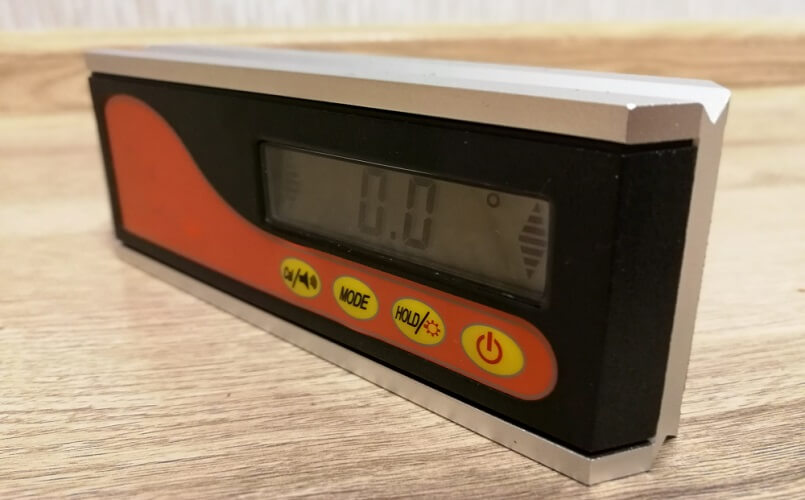
The hip moves either from the femur or the pelvis. For example, tilting the pelvis forward while standing moves the joint at the acetabulum and produces mild adduction at the top of the joint and a similarly low degree of abduction at the lower point.
Hip joint range of motion is limited due to the joint capsule, surrounding ligaments, and muscles. This is less the case during flexion where the soft tissue of the thigh and abdomen prevent the joint from being raised to a full 180 degrees. Abduction ROM is primarily limited by the pubofemoral ligament (see below).

Hip Abduction Braces
Hip abductor weakness often means that sufferers change how they walk or compensate with abnormal positions of the lower back, hip, and knee. While this immediately solves weakness, long-term effects can exacerbate the problem as well as increase hip joint weakness over time. Weak ligaments and muscles are common in babies and children. Until these strengthen over time, the hip joint is susceptible to dislocation. Both adult and pediatric cases are often prescribed hip braces.

A hip abduction brace is often used after hip replacement surgery or hip dislocation. It both prevents excessive movement and provides support. These braces need to be worn constantly, even when sleeping. Another term for this piece of medical equipment is hip abduction orthosis.
The baby hip abduction brace is placed on children with developmental hip dysplasia where weak ligaments and muscles make the joint unstable and the head of the femur is more likely to slip out of place – dislocation. In newborns, it is easy to realign an unstable hip joint. Over time the muscles and ligaments become stronger and the brace is no longer needed. The most common type of pediatric hip abduction brace is the Pavlik harness.
Another piece of equipment used after hip replacement surgery or surgery of the pelvis or femur is the hip abduction pillow. This triangular cushion is strapped to the inside of the legs when in bed and keeps the legs away from the midline.
Hip Abduction Exercises
Hip abduction exercises strengthen the muscles required for hip abduction and adduction as these movements are paired; when the exercised leg is brought back to midline you are adducting it. The simplest and best exercise for hip abduction muscles is standing abduction where each leg is lifted to the side one at a time, held in maximum abduction before any discomfort is felt, then slowly returned to the original position. It is important to have a good posture when doing so to prevent unwanted compensatory movement. If necessary, hold onto the back of a sturdy chair to improve balance.
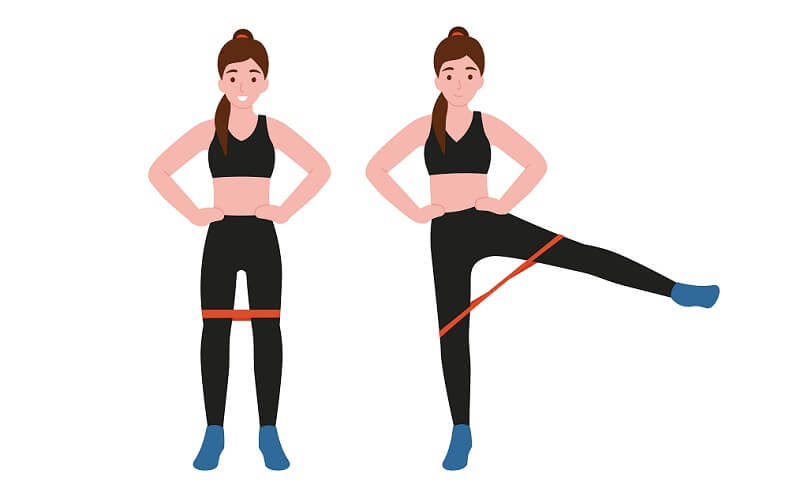
Seated hip abduction exercises are also possible and most gyms will have at least one hip abduction machine for this exercise. You will also find the hip abductor cable in the gym – a cable attached to the working ankle that provides weighted resistance for this motion.
Over time, and if the hip is not damaged, the hip abduction range of motion will increase. To further strengthen these muscle banded hip abduction exercises with an elasticated band around both ankles or thighs is recommended.

